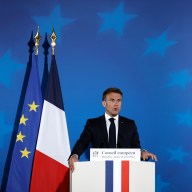 Audrey Tautou’s latest is “Mood Indigo,” in which she plays a woman with a water lily trapped in her lung.
Audrey Tautou’s latest is “Mood Indigo,” in which she plays a woman with a water lily trapped in her lung.
Credit: Getty Images
When we speak, Audrey Tautou hasn’t spoken English in two weeks. She keeps apologizing as she routinely searches for certain words. “It’s difficult for me in English when I want to say something that is beyond that of a seven-year-old child. In French I promise I have all the correct vocabulary,” she explains. “You’re my first [interview] of the day, so unfortunately for you this is a disaster.
“It can be frustrating,” she says of doing interviews in a language she’s not fully comfortable with. “I say these things and then when I read the piece I’m like, ‘Ooh la la la.’”
But she soldiers on anyway as we speak over a fuzzy transatlantic phone call, talking about a film that is tough to describe in words: “Mood Indigo,” a primarily visual movie made by film and music video director Michel Gondry. She took the job because of Gondry and because it’s adapted from a book, by Boris Vian from 1947, that she read when she was young. (It’s called “Mood Indigo” now, but historically it’s been published in America as either “Froth on the Daydream” or “Foam of the Daze.”)
In “Mood Indigo,” Tautou plays Chloe, a nice woman whose marriage to a playboy (Romain Duris) is put into jeopardy when she falls prey to a whimsical but deadly disease: she finds a water lily trapped in her lung.
“It felt like I was returning to my youth. It felt very nostalgic,” she says. But she knew it would be difficult to translate a novel so rich in absurdist imagery. “It seemed impossible to adapt this novel. I was awful curious to see how Gondry would bring it to life.” (In fact, the film has been adapted twice before, once in France in 1968 and in Japan in 2001, though neither is as intensely visual as Gondry’s film.)
Thing is, Gondry really did bring the film to life. He doesn’t use computers to create his effects; he makes them for real and has his actors work with them. “It was like we were children,” Tautou says. “We would be traveling around in a cloud. It was all right there. Nothing was digital.”
Gondry’s set was pretty chaotic too, but in a good way. “It was a big mess — which he created intentionally, to get us to forget about the camera and be more natural,” she explains. Gondy wouldn’t ask for silence then yell action; his cameras were constantly rolling. “It was pure disorder — just marvelous and so unusual. We wouldn’t know if the camera was on us or someone else. We felt very free.”
 Rather than do it in post, “Mood Indigo” director Michel Gondry had stars Audrey Tautou and Romain Duris actually get into a cloud vehicle.
Rather than do it in post, “Mood Indigo” director Michel Gondry had stars Audrey Tautou and Romain Duris actually get into a cloud vehicle.
Credit: Drafthouse Films
Tautou’s no stranger to visually strong filmmakers; her breakthrough was “Amelie,” directed within an inch of its life by Jean-Pierre Jeunet (with whom she later collaborated for “A Very Long Engagement”). But though the two are similar in some ways, their methods are not. “Jean-Pierre is a perfectionist; everything is prepared. Everything is perfectly timed, the lighting is beautiful,” she says. “Michel is the opposite. He likes when it’s not too beautiful, when it’s alive and everything’s a mess. They’re very different.”
Tautou’s career has long stood in the shadows of “Amelie,” which became an international sensation in 2001. Since then she’s been careful to show her diversity; soon after her breakthrough she acted in the gritty “Dirty Pretty Things,” and she barely breaks her signature smile in “Coco Before Chanel” and last year’s “Therese Desqueyroux.” But she’s not trying too hard to escape her big role.
“That’s my hit! That’s it. I’m really proud of it,” she says. “It would only be a problem if I hadn’t done any other movies.”
One thing she didn’t do was flock to America. (She did one American film: “The Da Vinci Code.”) She’s often said in interviews that she’s a French actress and she would never move to Los Angeles. But she’s not against Hollywood.
Would she do one of their films? “Yeah, of course. But I’m not the one who decides, huh? They aren’t waiting for me,” she says, laughing. “I’m not very social, I’m not very good at self-advertising. Next time I’m promoting a movie in America, I should just recite my list of preferred directors.”
I tell her now’s her chance. “But I haven’t prepared anything. I’d want to take this seriously.”
Follow Matt Prigge on Twitter @mattprigge
















